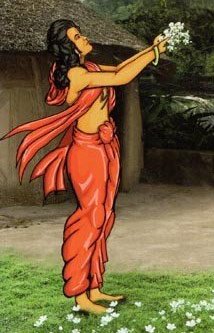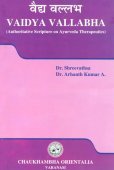Dadru: 18 definitions
Introduction:
Dadru means something in Hinduism, Sanskrit, Marathi, Hindi. If you want to know the exact meaning, history, etymology or English translation of this term then check out the descriptions on this page. Add your comment or reference to a book if you want to contribute to this summary article.
In Hinduism
Ayurveda (science of life)
Kalpa (Formulas, Drug prescriptions and other Medicinal preparations)
Source: Ancient Science of Life: Yogaśataka of Pandita VararuciDadru (दद्रु) refers to “ring worm” and is dealt with in the 10th century Yogaśataka written by Pandita Vararuci.—The Yogaśataka of Pandita Vararuci is an example of this category. This book attracts reader by its very easy language and formulations which can be easily prepared and have small number of herbs. It describes only those formulations which are the most common and can be used in majority conditions of diseases (viz., Dadru).
Source: Shodhganga: Edition translation and critical study of yogasarasamgrahaDadru (दद्रु) refers to “ringworm” and is one of the various diseases mentioned in the 15th-century Yogasārasaṅgraha (Yogasara-saṅgraha) by Vāsudeva: an unpublished Keralite work representing an Ayurvedic compendium of medicinal recipes. The Yogasārasaṃgraha [mentioning dadru] deals with entire recipes in the route of administration, and thus deals with the knowledge of pharmacy (bhaiṣajya-kalpanā) which is a branch of pharmacology (dravyaguṇa).
Cosmetics, Perfumery, Skin care and other Ayurvedic Beauty treatments
Source: Ancient Science of Life: Critical review of Ayurvedic Varṇya herbsDadru (दद्रु) refers to “urticaria” (a type of skin disease).—In Ayurveda, pitta and rakta vitiation are held responsible for impairment of skin health, lustre, colour as well as complexion and skin diseases such as visarpa (erysipelas), vyaṅga (melasma), śvitra (leucoderma), dadru (urticaria), pippalu (moles) to name a few, therefore herbs alleviating these two will act as skin lightening agents. [...] A few among them act indirectly as varṇya by alleviating rakta and pitta doṣa
Unclassified Ayurveda definitions
Source: Wisdom Library: Āyurveda and botanyDadru (दद्रु):—One of the eighteen types of Kuṣṭha (“skin disease”), according to the Caraka-saṃhitā (cikitsāsthāna), which is an important Sanskrit work dealing with Āyurveda. This condition of the skin (kuṣṭha) is caused by the corruption of the three doṣas (tridoṣa: vāta, pitta and kapha) which in turn corrupts the skin, blood, muscle and lymph. Dadru-kuṣṭha is characterized by the itching, redness, pimples and elevated round areas, similair in symptoms to Carmadala. Dadru is caused by a preponderance of Pitta-doṣa (‘bodily bile’) and Kapha-doṣa (‘bodily phlegm’).
Source: Ancient Science of Life: Vaidyavallabha: An Authoritative Work on Ayurveda TherapeuticsDadru (दद्रु) is mentioned as a disease that can be treated with metallic drugs including ingredients such as Sindhura and Gandhaka (sulphur), as mentioned in the 17th-century Vaidyavallabha (chapter 3) written by Hastiruci.—The Vaidyavallabha is a work which deals with the treatment and useful for all 8 branches of Ayurveda. The text Vaidyavallabha (mentioning dadru) has been designed based on the need of the period of the author, availability of drugs during that time, disease manifesting in that era, socio-economical-cultural-familial-spiritual-aspects of that period Vaidyavallabha.

Āyurveda (आयुर्वेद, ayurveda) is a branch of Indian science dealing with medicine, herbalism, taxology, anatomy, surgery, alchemy and related topics. Traditional practice of Āyurveda in ancient India dates back to at least the first millenium BC. Literature is commonly written in Sanskrit using various poetic metres.
Kavya (poetry)
Source: OpenEdition books: Vividhatīrthakalpaḥ (Kāvya)Dadru (दद्रु) in Sanskrit (or Dadda in Prakrit) refers to a “sort of worm disease”, as is mentioned in the Vividhatīrthakalpa by Jinaprabhasūri (13th century A.D.): an ancient text devoted to various Jaina holy places (tīrthas).—(CDIAL 6142; Emmerick 1986 p. 187).

Kavya (काव्य, kavya) refers to Sanskrit poetry, a popular ancient Indian tradition of literature. There have been many Sanskrit poets over the ages, hailing from ancient India and beyond. This topic includes mahakavya, or ‘epic poetry’ and natya, or ‘dramatic poetry’.
Languages of India and abroad
Marathi-English dictionary
Source: DDSA: The Molesworth Marathi and English Dictionarydadru (दद्रु).—m S Herpetic eruptions.
Marathi is an Indo-European language having over 70 million native speakers people in (predominantly) Maharashtra India. Marathi, like many other Indo-Aryan languages, evolved from early forms of Prakrit, which itself is a subset of Sanskrit, one of the most ancient languages of the world.
Sanskrit dictionary
Source: DDSA: The practical Sanskrit-English dictionaryDadru (दद्रु).—[dad-ru]
1) A cutaneous eruption, herpes.
2) A kind of leprosy.
3) A tortoise.
Derivable forms: dadruḥ (दद्रुः).
Source: Cologne Digital Sanskrit Dictionaries: Shabda-Sagara Sanskrit-English DictionaryDadru (दद्रु).—m.
(-druḥ) Cutaneous and herpetick eruptions; also dadrūḥ or with kan added dadruka m.
(-kaḥ).
--- OR ---
Dadrū (दद्रू).—m.
(-drūḥ) Herpetick eruptions: see dadru.
--- OR ---
Dadrū (दद्रू).—m.
(-rdrūḥ) Cutaneous eruption, herpes. E. daridrā to be poor, ū Unadi affix, the form is irregular: by substituting the short vowel, and omitting the first ra, this word and its compounds appear in a variety of forms, as dadru, dadrū, dardrū; also omitting the second ra, dardrū, &c. &c. q. v.
Source: Cologne Digital Sanskrit Dictionaries: Benfey Sanskrit-English DictionaryDadru (दद्रु).—i. e. a reduplicated form of dṛ10 + u, m. and f. rū, A kind of cutaneous eruption, [Suśruta] 1, 31, 17; 2, 66, 6.
Source: Cologne Digital Sanskrit Dictionaries: Cappeller Sanskrit-English DictionaryDadru (दद्रु).—[feminine] a kind of leprosy.
--- OR ---
Dadrū (दद्रू).—[feminine] a kind of leprosy.
Source: Cologne Digital Sanskrit Dictionaries: Monier-Williams Sanskrit-English Dictionary1) Dadru (दद्रु):—[from dadṛt] m. a tortoise, [Uṇādi-vṛtti]
2) [v.s. ...] f. (also dara, [Uṇādi-sūtra] k.) = drū, [Suśruta i, 11 and 45; v, 8.]
3) Dadrū (दद्रू):—[from dadṛt] f. ([Pāṇini 5-2, 100], [vArttika] l and, [Patañjali]) a cutaneous eruption, kind of leprosy (also dard, [Uṇādi-sūtra i, 92 and] dardū [Scholiast or Commentator]), [Suśruta iv, 9; Varāha-mihira’s Bṛhat-saṃhitā xxxii, 14.]
Source: Cologne Digital Sanskrit Dictionaries: Yates Sanskrit-English Dictionary1) Dadru (दद्रु):—(druḥ) 2. m. Cutaneous eruption.
2) Dadrū (दद्रू):—(drūḥ) 3. m. Eruptions.
Source: DDSA: Paia-sadda-mahannavo; a comprehensive Prakrit Hindi dictionary (S)Dadru (दद्रु) in the Sanskrit language is related to the Prakrit word: Daddu.
[Sanskrit to German]
Sanskrit, also spelled संस्कृतम् (saṃskṛtam), is an ancient language of India commonly seen as the grandmother of the Indo-European language family (even English!). Closely allied with Prakrit and Pali, Sanskrit is more exhaustive in both grammar and terms and has the most extensive collection of literature in the world, greatly surpassing its sister-languages Greek and Latin.
Hindi dictionary
Source: DDSA: A practical Hindi-English dictionaryDadru (दद्रु):—(nm) ring-worm.
...
Kannada-English dictionary
Source: Alar: Kannada-English corpusDadru (ದದ್ರು):—[noun] = ದದ್ದು [daddu]1.
Kannada is a Dravidian language (as opposed to the Indo-European language family) mainly spoken in the southwestern region of India.
See also (Relevant definitions)
Starts with: Dadrughna, Dadruka, Dadrukushtha, Dadrula, Dadrumat, Dadruna, Dadrunashini, Dadruroga, Dadrurogin, Tatrupam.
Ends with: Gudadru, Madadru, Nidadru, Shiladadru, Udadru.
Full-text (+14): Dadrughna, Dadrurogin, Dardu, Shiladadru, Dadruka, Dadruroga, Daddu, Dadruna, Dadrukushtha, Dadrunashini, Peyttattu, Tattururokam, Dadrana, Shukanashana, Dadada, Dadda, Lutavisha, Vyanga, Pippalu, Visarpa.
Relevant text
Search found 13 books and stories containing Dadru, Dadrū; (plurals include: Dadrus, Dadrūs). You can also click to the full overview containing English textual excerpts. Below are direct links for the most relevant articles:
Rig Veda (translation and commentary) (by H. H. Wilson)
Sushruta Samhita, volume 2: Nidanasthana (by Kaviraj Kunja Lal Bhishagratna)
Rasa Jala Nidhi, vol 3: Metals, Gems and other substances (by Bhudeb Mookerjee)
Part 5 - Two kinds of ksharas (liquid and solid) < [Chapter XXVIII - Kshara (akalis)]
Expiatory Rites in Keralite Tantra (by T. S. Syamkumar)
4.2. Diseases and Expiatory Rites < [Chapter 1 - Expiatory Rites: Concept and Evolution]
Atharvaveda and Charaka Samhita (by Laxmi Maji)
4b. Leprosy (Kuṣṭha) in the Caraka-saṃhitā < [Chapter 5 - Diseases and Remedies in Atharvaveda and Caraka-Saṃhitā]
Kāśyapa Saṃhitā (Āyurveda book) < [Chapter 1 - Introduction]
The Garuda Purana (by Manmatha Nath Dutt)
Chapter CC - Various other medicinal Recipes (continued) < [Dhanvantari Samhita]
Related products

